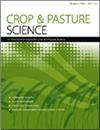病毒复合体苜蓿矮缩病感染对苜蓿植株生产性状和甘美醇产量的影响
IF 1.9
4区 农林科学
Q2 AGRICULTURE, MULTIDISCIPLINARY
引用次数: 0
摘要
病毒感染会影响苜蓿的生长、种子生产、固氮功能受损和对真菌疾病的易感性,从而造成产量损失,但也会刺激谷氨醇的产生,谷氨醇在牲畜和人类中表现出雌激素活性。目的研究紫花苜蓿病毒复合体侵染后紫花苜蓿植株库梅甾醇含量的变化及其与形态性状和产量性状的关系。方法采用摩纳哥SP-INTA品种的7个基因型和trul PV-INTA品种的6个基因型。克隆了未感染和感染苜蓿病毒复合体(苜蓿矮缩病)的植株。评估了产量和形态性状。采用疾病症状评估基因型严重指数(GSI, %),采用高压液相色谱法测定库美醇含量。主要结果病毒感染降低了大多数白颈雀基因型的节间距离(iD),而在Traful基因型中则受到影响,产生侏儒症。仅在摩纳哥基因型中,iD降低与GSI呈正相关。库美特尔含量在两个品种的基因型之间存在差异。摩纳哥基因型的范围在350至1140 ppm(感染和未感染)之间,而特拉尔基因型的范围在0至942 ppm(感染和未感染)之间。然而,病毒感染仅在三种基因型中促进了谷氨醇的增加。GSI表明,所有研究的Monarca基因型似乎比Traful基因型对病毒感染更敏感。与品种无关,三种基因型的库米雌醇含量均增加。高谷丙醇含量与低GSI相关。结论基因型对病毒感染反应的了解将有助于育种者选择优良的基因型,以及培育作为饲料或天然植物雌激素来源的新品种。本文章由计算机程序翻译,如有差异,请以英文原文为准。
Effects of infection with the viral complex alfalfa dwarf disease on productivity traits and coumestrol production in alfalfa plants
Context Viral infections generate yield losses in alfalfa due to the impact on growth, seed production, impaired nitrogen fixation and fungal disease susceptibility, but also stimulate production of coumestrol, which can exhibit oestrogenic activity in livestock and human.Aims We investigated the change in coumestrol content and its relationship with morphological and productivity traits in alfalfa plants infected with alfalfa viral complex.Methods Seven genotypes from cultivar Monarca SP-INTA and six of Traful PV-INTA were used. Plants were cloned and treated as non-infected and infected with alfalfa viral complex (alfalfa dwarf disease). Productivity and morphological traits were assessed. Disease symptoms were used to estimate the genotype severity index (GSI, %), coumestrol content was determined by high pressure liquid chromatography.Key results Viral infection reduced internode distance (iD) for the majority of Monarca genotypes, whereas in Traful one was affected, generating dwarfism. The iD reduction positively correlated with GSI only in Monarca genotypes. Coumestrol content varied between genotypes of each of the two cultivars. Monarca genotypes ranged between 350 and 1140 (infected and non-infected) ppm, and Traful genotypes ranged between 0 and 942 (infected and non-infected) ppm. However, viral infection promoted coumestrol increase in three genotypes only.Conclusions All Monarca genotypes studied seem to be more sensitive to viral infections than those of Traful, as GSI demonstrated. Independently of cultivar, coumestrol content increased for three genotypes. High coumestrol content was correlated with low GSI.Implications The knowledge of genotype response to viral infections would be useful for breeders to select superior genotypes as well as to originate new cultivars either as forage or as natural sources of phytoestrogens.
求助全文
通过发布文献求助,成功后即可免费获取论文全文。
去求助
来源期刊

Crop & Pasture Science
AGRICULTURE, MULTIDISCIPLINARY-
CiteScore
4.20
自引率
15.80%
发文量
111
审稿时长
3 months
期刊介绍:
Crop and Pasture Science (formerly known as Australian Journal of Agricultural Research) is an international journal publishing outcomes of strategic research in crop and pasture sciences and the sustainability of farming systems. The primary focus is broad-scale cereals, grain legumes, oilseeds and pastures. Articles are encouraged that advance understanding in plant-based agricultural systems through the use of well-defined and original aims designed to test a hypothesis, innovative and rigorous experimental design, and strong interpretation. The journal embraces experimental approaches from molecular level to whole systems, and the research must present novel findings and progress the science of agriculture.
Crop and Pasture Science is read by agricultural scientists and plant biologists, industry, administrators, policy-makers, and others with an interest in the challenges and opportunities facing world agricultural production.
Crop and Pasture Science is published with the endorsement of the Commonwealth Scientific and Industrial Research Organisation (CSIRO) and the Australian Academy of Science.
 求助内容:
求助内容: 应助结果提醒方式:
应助结果提醒方式:


